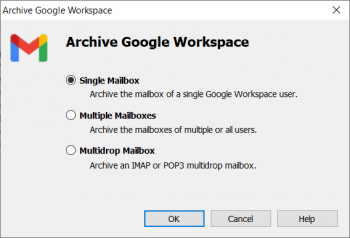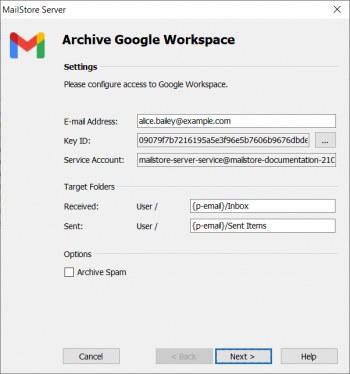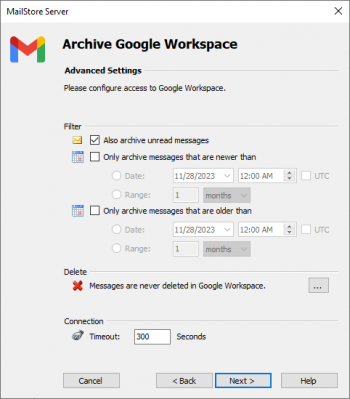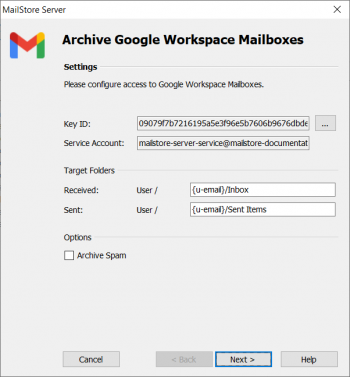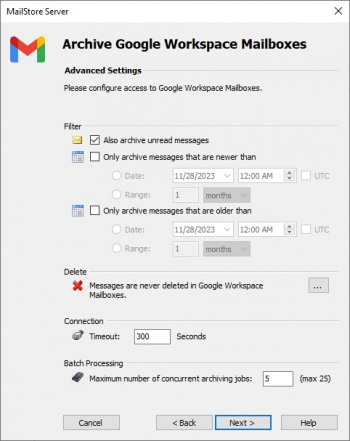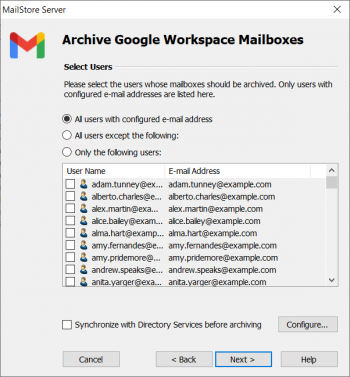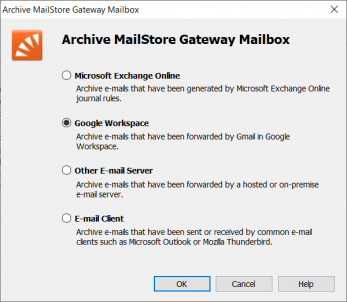Archiving Emails from Google Workspace
This implementation guide covers the specifics of archiving G Suite mailboxes. It is assumed that you already have a MailStore Server installation or test installation and are familiar with the fundamentals of MailStore Server. Please refer to the Manual or the Quick Start Guide for more information.
MailStore Server offers several ways to archive emails from G Suite mailboxes, which are described below. If you are not sure which archiving method best suits your company, please refer to the chapter Choosing the Right Archiving Strategy.
Synchronizing Users
It is required to first set up a synchronization with G Suite as described in chapter G Suite Integration of the MailStore Server manual as the API credentials needed to configure archiving must first be created in the G Suite Integration configuration process.
Note that while G Suite uses it's own internal user database, this itself can be synchronized with external LDAP or Active Directory environments. Even if the G Suite directory is not the primary source of user account information, it is highly recommended to synchronize MailStore Server directly with G Suite to fetch all relevant information such as email addresses.
Archiving Individual Mailboxes
The following steps describe the setup of a single mailbox archiving profile by an administrator using a special service account. Alternatively, a single Gmail mailbox can also be archived using the GMail archiving profile in MailStore where the mailbox owner authorizes mailbox access by MailStore Server through OAuth.
In MailStore Server G Suite archiving tasks are stored in archiving profiles. By following the procedure described here you can archive a single G Suite mailbox for a specific MailStore user. The archiving process can be executed manually or automatically. You can find further information about executing archiving profiles in chapter Email Archiving with MailStore Basics.
Please proceed as follows for each individual mailbox:
- Make sure that you configured the service account as descibes in the G Suite Integration chapter of the MailStore Server manual.
- Log on to MailStore Client as MailStore administrator. Only an administrator can archive emails via a G Suite Service Account.
- Click on Archive Email.
- From the Email Servers list in the Create Profile area of the window, select G Suite to create a new archiving profile.
- A wizard opens to assist in specifying the archiving settings.
- Select Single Mailbox and click on OK.
- Configure the basic archiving settings. The JSON file generated by Google for the service account during the G Suite Integration configuration is also required for mailbox access.
- Fill out the following fields:
- Email Address
The email address of the user to be archived. - Key ID
To import the private key, select the JSON file that has been generated by Google for the service account. - Service Account
The service account is determined automatically from the JSON file. - Received and Sent
The target folder in which MailStore will store received and send email. - Archive Spam
G Suite spam folders are excluded by default, but can be archived by selecting this option.
- Important notice: MailStore will archive all mail contained within the selected mailbox, excluding Spam and Deleted messages. Due to the nature of how Google represents user defined labels in IMAP, they are not supported by MailStore; as a consequence, the entire mailbox will be archived.
- Click on Next.
- If needed, adjust the filter and the deletion rules. By default, no emails will be deleted from the mailbox. The Timeout value only has to be adjusted in specific cases. Please keep in mind that these settings apply to all mailboxes to be archived.
- Click on Next.
- The Target Archive must be specified. Select the archive of the user for whom the selected mailbox is to be archived. If the user does not exist yet, click on Create a New User.
- Click on Next.
- In the last step, a name for the archiving profile can be specified. After clicking Finish, the archiving profile will be listed under Saved Profiles and can be run immediately or automatically, if desired.
More information on how to execute archiving profiles can be found under the topic Email Archiving with MailStore Basics
Archiving Multiple Mailboxes Centrally
By following the procedure described here, multiple G Suite mailboxes can be archived without specific configuration for each MailStore user. The archiving process can be executed manually or automatically.
- Make sure that you configured the service account as described in the G Suite Integration chapter of the MailStore Server manual.
- Log on to MailStore Client as MailStore administrator. Only an administrator can archive emails via a G Suite Service Account.
- Click on Archive Email.
- From the Email Servers list in the Create Profile area of the window, select G Suite to create a new archiving profile.
- A wizard opens to assist in specifying the archiving settings.
- Select Multiple Mailboxes and click on OK.
- Configure the basic archiving settings. The JSON file generated by Google for the service account during the G Suite Integration configuration is also required for mailbox access.
- Fill out the following fields:
- Key ID
To import the private key, select the JSON file that has been generated by Google for the service account. - Service Account
The service account is determined automatically from the JSON file. - Received and Sent
The target folder in which MailStore will store received and send email. - Archive Spam
G Suite spam folders are excluded by default, but can be archived by selecting this option.
- Important notice: MailStore will archive all mail contained within the selected mailbox, excluding Spam and Deleted messages. Due to the nature of how Google represents user defined labels in IMAP, they are not supported by MailStore, as a consequence, the entire mailbox will be archived.
- Click on Next.
- If needed, adjust the filter and the deletion rules. By default, no emails will be deleted from the mailbox. The Timeout value only has to be adjusted in specific cases. Please keep in mind that these settings apply to all mailboxes to be archived.
- Click on Next.
- Select the users whose mailboxes are to be archived.
- The following options are available:
- All users with configured email address
Choose this option to archive the mailboxes of all users who are set up, along with their email addresses, in MailStore's user management. - All users except the following
Choose this option to exclude individual users (and thereby their G Suite mailboxes) from the archiving process, using the list of users below. - Only the following users
Choose this option to include individual users (and thereby their G Suite mailboxes) in the archiving process, using the list of users below. Only the mailboxes of those users explicitly specified will be archived. - Synchronize with Directory Services before archiving
If selected, the MailStore user list will be synchronized with the configured directory service before any archiving process is executed. This has the advantage that, for example, new employees will be created as MailStore users before archiving, so once the archiving process is executed, their G Suite mailbox is archived automatically as well. This option is especially recommended when the archiving process is to be executed automatically.
- Click on Next.
- In the last step, a name for the archiving profile can be specified. After clicking Finish, the archiving profile will be listed under Saved Profiles and can be run immediately or automatically, if desired.
Archiving Incoming and Outgoing Emails Directly
MailStore can archive all incoming and outgoing emails of all users within a G Suite email domain. Using this scenario it is possible to ensure a complete and compliant archive.
Basic Functionality
In G Suite, Google Mail can be configured to forward a copy of all incoming, outgoing or internal email traffic to an external mailbox.
The free MailStore Gateway program provides mailboxes that are suitable as target for the corresponding G Suite rules. In contrast to using an other 3rd party mailbox provider, this method ensures that emails remain unmodified and the important X-Gm-Original-To is retained.
MailStore Server is then configured to archive from the MailStore Gateway mailboxes at regular intervals. During this process, the emails from the MailStore Gateway mailbox will be assigned to their respective MailStore users (i.e. their user archives) automatically. This means that each user is able to view only their own emails.
Step 1: Setup and Configure MailStore Gateway
Please refer to the MailStore Gateway Manual for detailed instructions about:
- Installation and Setup of MailStore Gateway
- Logging on to MailStore Gateway's Management Console
- Creating MailStore Gateway mailboxes
After these steps, a mailbox with an individual email address (i.e. [email protected]) should exist.
Step 1: Configuring email forwarding for a G Suite email domain
Please proceed as follows:
- Log on to your G Suite domain as an administrator.
- Navigate to Apps > G Suite > Settings for Gmail > Advanced settings.
- Configure Receiving routing:
- Under Also deliver to, activate the Add more recipients option.
- Select Advanced and activate the Change envelope recipient option.
- Enter the email address of the multidrop mailbox into the Replace recipient field.
- Activate the Add X-Gm-Original-To header option.
- Click on Save further down the window and then on Add setting.
- Under Also deliver to, activate the Add more recipients option.
- Repeat steps 1 to 5 for Sending routing.
- Click on Save changes.
Step 2: Setting up the Archiving Process
Setting up archiving processes for MailStore Gateway mailboxes is done using archiving profiles. General information about archiving profiles is available in chapter Working with Archiving Profiles.
Before configuring MailStore Server, please make sure that a MailStore Server user account exists for each user whose emails are to be archived with the MailStore Gateway. Please refer to chapter User Management for more information.
Important notice: It is imperative that, in user management under Properties, the email address is specified for each user. This is the only way to make sure that the emails in the archive are assigned to the appropriate users. If the POP3 user name does not match the user's email address, the user name has to be added separately.
Please proceed as follows:
- Log on as MailStore Server administrator using MailStore Client.
- In MailStore Server, click on Archive Email.
- To create a new archiving profile, select MailStore Gateway Mailbox from the Email Server list in the Create Profile area of the application window.
- A wizard opens that guides you through the setup process.
- Select Google G Suite and click OK.
Please note: To be able to archive a MailStore Gateway mailbox, MailStore Server users along with their email addresses must exist in the MailStore Server user management. If this is not the case, MailStore Server will offer to set up and run the directory synchronization at this point. Once completed, the wizard will resume.
Alternatively, you can cancel the wizard and create users manually as described the in chapter User Management.
- Fill out the fields Host, Mailbox ID and Password. Click on Test to verify the data entered.
If MailStore Gateway uses a TLS certificate from a certificate authority that is not trusted by the MailStore Server computer, the option Accept all certificates must be checked.
- Adjust any further settings such as how to handle emails with unknown addresses or asking MailStore Server to delete emails after they have been archived.
Please note: If you are additionally archiving messages from the users mailboxes, you have to set the target folder names here to the folder names that match the names that were created by the user mailbox archiving profiles. Otherwise, additional or similar folders could be created in the users' archives. The folder names are case-sensitive.
- If the option Synchronize with Directory Services before archiving is enabled, the MailStore Server user list will be synchronized with the configured directory service before the archiving process actually runs. This has the advantage that, for example, new employees will be created as MailStore Server users before archiving which enables MailStore Server to sort their emails into the correct archives.
- Click on Next.
- The timeout value only has to be adjusted on a case-by-case basis (e.g. with very slow servers or network connections).
- Click on Next.
- At the last step, select a name for the new archiving profile. After clicking on Finish, the archiving profile will be listed under Saved Profiles and can be run immediately or automatically, if desired.
